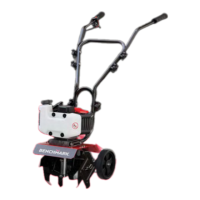26
8. TILLING TIPS
8.1 TILLING
To allow for machine cultivating after the plants have grown, leave
enough clearance room for the tiller between the seed rows.
When tilling unbroken ground or extremely hard soil, till at a shallow
height by setting the clevis pin in the highest hole of the depth regulator.
Make several light passes over the area, then adjust the depth regulator
for deeper depths with successive passes.
If the tiller jumps or skids uncontrollably, set the depth regulator to
a shallower height. Hold rmly to the handlebars to control sudden
lurches.
Immediately release the control levers if the tines jam or you strike a
foreign object. With the control levers in the neutral position, turn off the
engine and wait for the tines to stop. Disengage the spark plug wire.
Remove foreign objects and check for damage.
NOTE
Remove sod from the soil before tilling. It is not recommended to till sod
into soil.
Always begin with a shallow cut on the rst pass, and then work an inch
or two deeper on each successive pass.
Avoid working with soggy or wet soil. Wet soil can cause slips and falls,
and is more prone to sticking and jamming the working parts of the tiller.
Wait a day or two after heavy rain for the ground to dry.
8.2 CULTIVATING
Plant rows on 20” - 22” (51 - 56cm) centers for ease of turning.
Set the depth regulator lever with the clevis pin in one of the higher
holes. This will allow for shallow cultivation necessary to turn over
weeds and break up and aerate the soil.

